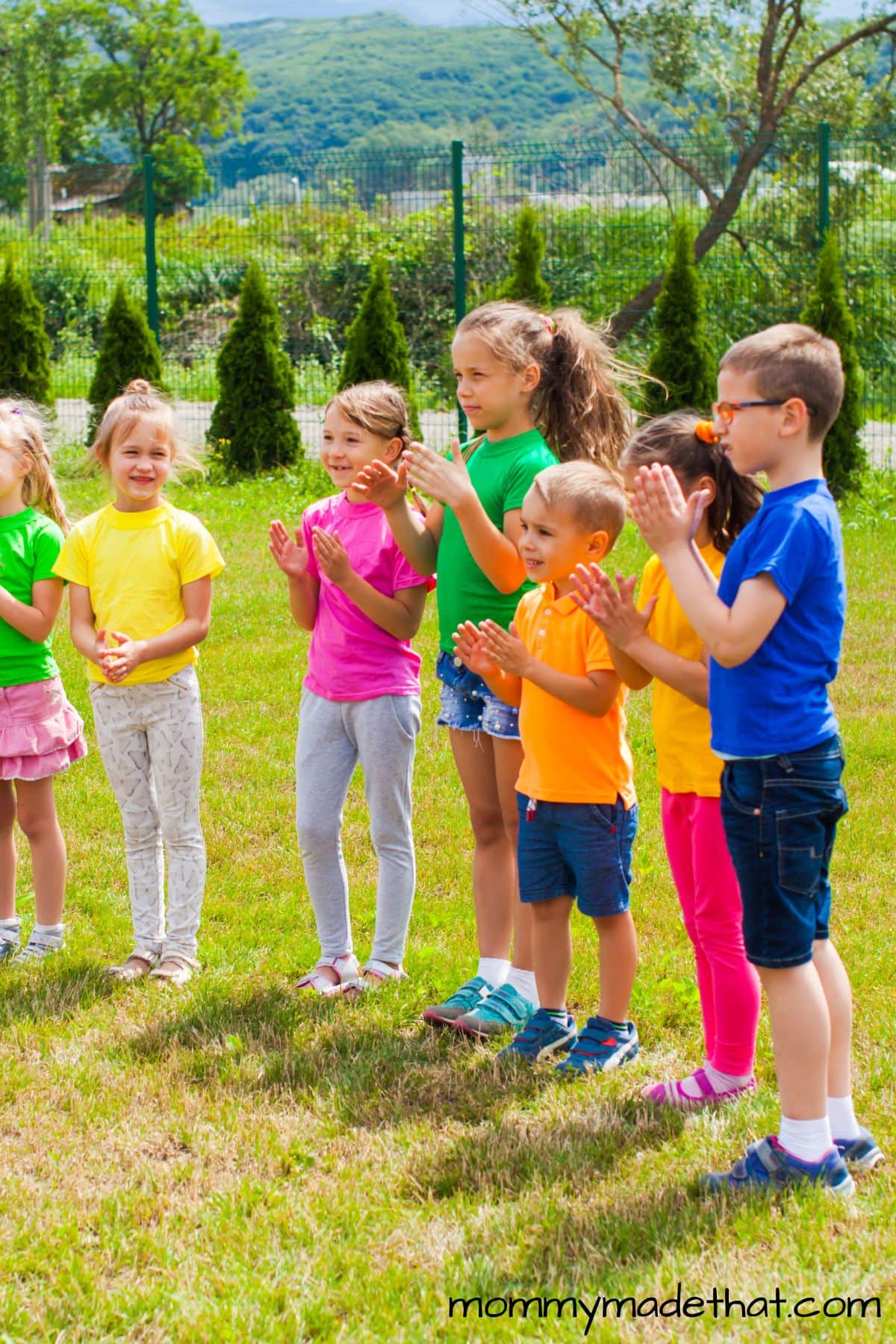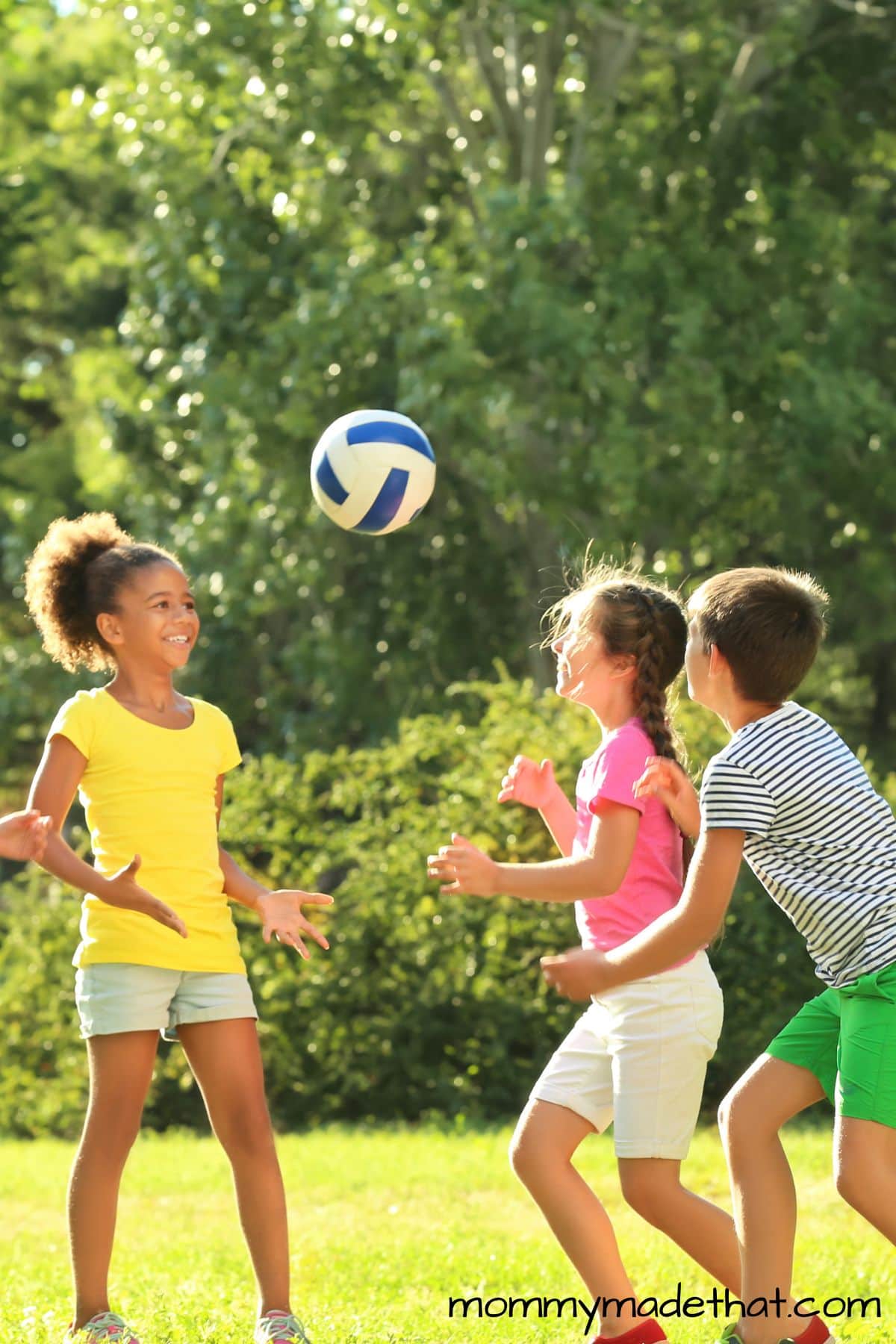How to Play Duck Duck Goose
Need to learn how to play duck duck goose? We’ve got you covered, from the basic rules, tips to playing the classic kids game to variations.

Ready to play some Duck Duck Goose? This classic group game for kids is loved by children, families, and schoolteachers for generations.
This timeless favorite promotes physical activity and social skills while offering endless entertainment.
It’s one of our go to group games for kids.
Table of Contents
Benefits & Skills Developed for Kids
As parents and educators, we want our children to grow up healthy and well-rounded.
Playing games like Duck Duck Goose can help our children develop key skills that will serve them well throughout their lives.
Physical Benefits
Playing Duck Duck Goose provides physical benefits that are essential for children’s growth and development. These benefits include:
- Increased stamina: The game involves chasing and running, which helps children build their endurance.
- Improved coordination: The game requires quick movements and changes in direction, which helps children develop their coordination and balance.
- Gross motor skill development: The game involves large muscle groups, which helps children develop their gross motor skills.
Cognitive Benefits
Playing Duck Duck Goose also provides cognitive benefits that help children develop their minds and intelligence. These benefits include:
- Improved concentration and focus: The game requires children to pay attention to the player who is “it.” This helps them to improve their concentration and focus.
- Better problem-solving and decision-making ability: The game requires children to make quick decisions and problem-solve on the spot, which helps them to develop these skills.
Social Benefits
Playing Duck Duck Goose also provides social benefits that help children develop their social skills, such as:
- Taking turns: The game requires children to take turns being “it,” which helps them to learn the importance of sharing and taking turns.
- Sharing: The game encourages children to share their spot in the circle, which helps them to learn how to share with others.
- Communication: The game requires children to communicate with each other, which helps them to develop their communication skills.
Emotional Benefits
Playing Duck Duck Goose can also provide emotional benefits that help children develop their emotional intelligence, including:
- Coping with winning and losing: The game provides opportunities for children to experience winning and losing, which helps them learn how to cope with both.
- Dealing with stress: The game can be fast-paced and exciting, which helps children learn how to manage their stress levels.

How to the Play Duck Duck Goose Game
Here are the basics on how to play duck duck goose.
How Many Players: Duck Duck Goose is a versatile game that can be enjoyed by as few as three players or expanded to accommodate larger groups.
Ideally, a group of six or more players will make the game more engaging and fun, allowing for a greater variety of “Ducks” and “Geese.”
Suitable age groups: The simplicity of Duck Duck Goose makes it an ideal game for a wide range of ages.
Children as young as 2 or 3 years old can participate with assistance, while older kids can enjoy the game independently.
Even adults can join in on the fun, making Duck Duck Goose a fantastic activity for family gatherings, school events, or any occasion where people come together for some lighthearted entertainment.
Necessary materials: One of the great advantages of Duck Duck Goose is that it requires no special equipment or materials.
All you need is enough space for players to form a circle and run around it, whether indoors or outdoors.
Grass fields, playgrounds, gymnasiums, or even living rooms can serve as suitable playing areas.
Just ensure that the surface is safe and free from obstacles to prevent any accidents during the exciting chase.
Setting Up the Game
Forming the circle: To set up a game of Duck Duck Goose, gather all the players and have them form a circle by sitting down cross-legged, facing inward.
Make sure there is enough space between each player for comfortable movement and to allow the “Goose” to run around the circle during the chase.
The larger the circle, the more challenging and fun the game becomes.
Choosing the first “Goose”: There are several ways to select the first “Goose” who will initiate the game.
You can opt for a random selection, such as drawing names from a hat, or use a playful method like a short round of “Rock, Paper, Scissors.”
Alternatively, you can let the youngest or oldest player start the game, or simply ask for a volunteer.
Once the first “Goose” has been chosen, they will stand up and begin walking around the outside of the circle to start the game.
Playing the Game
The “Duck” selection process: The chosen “Goose” will walk around the outside of the circle, gently tapping each player on the head while saying “Duck.”
It’s important to tap only once per player and not skip anyone during this process. The “Goose” should keep a steady pace and maintain an element of surprise to keep the other players on their toes.
Tapping heads and saying “Duck”: As the “Goose” taps each player on the head, they must say “Duck” clearly and audibly.
This simple action builds anticipation among the players, as they eagerly await the moment when the “Goose” will tap someone and say “Goose” instead, signaling the beginning of the chase.
The moment of choosing the “Goose”: The “Goose” can select any player to be the new “Goose” by tapping their head and saying “Goose” instead of “Duck.”
The chosen player must then quickly stand up and attempt to tag the original “Goose” before they can take the vacant spot in the circle.
The chase around the circle: Both the original “Goose” and the new “Goose” must now run around the circle in the same direction, with the new “Goose” trying to tag the original “Goose” before they can sit down in the open spot.
The chase should be fast-paced and exciting, as both players try to outmaneuver each other.
Returning to the open spot and resuming the game: If the original “Goose” successfully reaches the open spot in the circle without being tagged, they can sit down safely, and the new “Goose” will continue the game by walking around the circle and repeating the “Duck” selection process.
However, if the new “Goose” manages to tag the original “Goose” before they can sit down, the original “Goose” must try again by walking around the circle and selecting another player as the new “Goose.”
The game continues in this manner, providing endless rounds of excitement and laughter.

Key Rules to Remember
To ensure a fair and enjoyable game of Duck Duck Goose, it’s crucial to keep the following key rules in mind:
No skipping or double-tapping players: When selecting “Ducks” and choosing the new “Goose,” the player walking around the circle must tap each person on the head only once and should not skip anyone.
Skipping or double-tapping creates confusion and disrupts the flow of the game.
By adhering to this rule, players maintain a sense of fairness and anticipation throughout the game.
Running in the same direction during the chase: Both the original “Goose” and the new “Goose” must run in the same direction around the circle when the chase begins.
This rule ensures that both players have an equal chance to reach the open spot and keeps the game challenging and exciting.
Changing direction mid-chase can lead to collisions and confusion, detracting from the fun and lighthearted spirit of the game.
The importance of sitting down quickly after being tagged: If a player is tagged by the new “Goose” during the chase, they must quickly return to the circle and sit down in the open spot.
This prompt action allows the game to continue smoothly without any delays. Sitting down quickly also reinforces the importance
Variations of Duck Duck Goose
Duck, Duck, Goose is a classic children’s game enjoyed by many. There are many different variations of the original game, and I’ve come up with four unique variations to add a new twist to your next game night.
Jungle Safari
For this variation, you’ll need:
- Animal Masks (or temporary face paint or headbands)
- Large room or open outdoor space
How to play: Players sit in a circle with animal masks (face paint or headbands) on. The person who is “it” walks around the circle tapping each animal on the head and calling out their animal.
Once they reach the chosen player, they tap them on the head and say, “Jungle!” instead of “Goose!” That player must jump up and try to tag the person who is “it” before they reach the empty spot in the circle.
Superhero Tag
For this variation, you’ll need:
- Superhero costumes or capes (optional)
- Open outdoor space
How to play: Players sit in a circle, and the person who is “it” walks around the circle tapping each player on the head and calling out their superhero name.
Once they reach the chosen player, they tap them on the head and say, “Superpower!” instead of “Goose!” That player must jump up and try to tag the person who is “it” before they reach the empty spot in the circle.
Players can wear superhero capes for added fun.
Beach Bash
For this variation, you’ll need:
- Beach towels or mats
- Large room or outdoor space
How to play: Players sit in a circle on beach towels or mats on the ground. The person who is “it” walks around the circle, tapping each player on the head and calling out “Splish!”
Instead of “Duck!” Once they reach the chosen player, they tap them on the head and say, “Splash!” instead of “Goose!”
That player must jump up and try to race around the circle before the person who is “it” can sit in their open spot.
Musical “Duck, Duck, Goose
For this variation, you’ll need:
- Music/party speaker
- Large room or outdoor space
- Soft ball
How to play: This variation is played like musical chairs. Instead of tapping people on the head, players walk around as music plays and all players follow in a circle.
When the music stops, the player standing in front of them throws a a ball as high as they can.
They then sit down and try to grab the ball when it lands. If they catch it, they essentially are safe for that round the person to their right becomes the new “it” and the game continues. If they drop it, they become the new “it.”
With these unique variations, your next game of Duck, Duck, Goose will be more exciting than ever.
Incorporating different props, costumes, or themes will give your game night an extra boost of creativity and imagination.
Playing Duck Duck Goose is more than just a simple children’s game. It’s a timeless classic that can bring friends and family together for a thrilling, lighthearted competition.
So make sure to give it a try with your kiddos.






